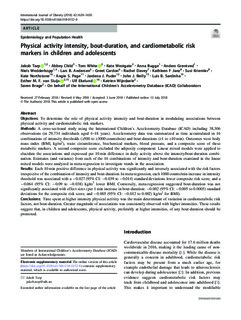| dc.contributor.author | Tarp, Jakob | |
| dc.contributor.author | Child, Abbey | |
| dc.contributor.author | White, Tom | |
| dc.contributor.author | Westgate, Kate | |
| dc.contributor.author | Bugge, Anna | |
| dc.contributor.author | Grøntved, Anders | |
| dc.contributor.author | Wedderkopp, Niels | |
| dc.contributor.author | Andersen, Lars Bo | |
| dc.contributor.author | Cardon, Greet | |
| dc.contributor.author | Davey, Rachel | |
| dc.contributor.author | Janz, Kathleen F | |
| dc.contributor.author | Kriemler, Susi | |
| dc.contributor.author | Northstone, Kate | |
| dc.contributor.author | Page, Angie S. | |
| dc.contributor.author | Puder, Jardena J | |
| dc.contributor.author | Reilly, John J | |
| dc.contributor.author | Sardinha, Luis B | |
| dc.contributor.author | van Sluijs, Esther M F | |
| dc.contributor.author | Ekelund, Ulf | |
| dc.contributor.author | Wijndaele, Katrien | |
| dc.contributor.author | Brage, Søren | |
| dc.date.accessioned | 2019-01-07T11:35:01Z | |
| dc.date.available | 2019-01-07T11:35:01Z | |
| dc.date.created | 2018-09-17T12:16:01Z | |
| dc.date.issued | 2018 | |
| dc.identifier.citation | International Journal of Obesity. 2018, 42, 1639-1650. | nb_NO |
| dc.identifier.issn | 0307-0565 | |
| dc.identifier.uri | http://hdl.handle.net/11250/2579452 | |
| dc.description.abstract | Objectives: To determine the role of physical activity intensity and bout-duration in modulating associations between physical activity and cardiometabolic risk markers. Methods: A cross-sectional study using the International Children’s Accelerometry Database (ICAD) including 38,306 observations (in 29,734 individuals aged 4–18 years). Accelerometry data was summarized as time accumulated in 16 combinations of intensity thresholds (≥500 to ≥3000 counts/min) and bout-durations (≥1 to ≥10 min). Outcomes were body mass index (BMI, kg/m2 ), waist circumference, biochemical markers, blood pressure, and a composite score of these metabolic markers. A second composite score excluded the adiposity component. Linear mixed models were applied to elucidate the associations and expressed per 10 min difference in daily activity above the intensity/bout-duration combination. Estimates (and variance) from each of the 16 combinations of intensity and bout-duration examined in the linear mixed models were analyzed in meta-regression to investigate trends in the association. Results: Each 10 min positive difference in physical activity was significantly and inversely associated with the risk factors irrespective of the combination of intensity and bout-duration. In meta-regression, each 1000 counts/min increase in intensity threshold was associated with a −0.027 (95% CI: −0.039 to −0.014) standard deviations lower composite risk score, and a −0.064 (95% CI: −0.09 to −0.038) kg/m2 lower BMI. Conversely, meta-regression suggested bout-duration was not significantly associated with effect-sizes (per 1 min increase in bout-duration: −0.002 (95% CI: −0.005 to 0.0005) standard deviations for the composite risk score, and −0.005 (95% CI: −0.012 to 0.002) kg/m2 for BMI). Conclusions: Time spent at higher intensity physical activity was the main determinant of variation in cardiometabolic risk factors, not bout-duration. Greater magnitude of associations was consistently observed with higher intensities. These results suggest that, in children and adolescents, physical activity, preferably at higher intensities, of any bout-duration should be promoted. | nb_NO |
| dc.language.iso | eng | nb_NO |
| dc.subject | adolescent | |
| dc.subject | biomarkers | |
| dc.subject | blood glucose / analysis | |
| dc.subject | blood pressure | |
| dc.subject | body mass index | |
| dc.subject | cardiovascular diseases / epidemiology | |
| dc.subject | child | |
| dc.subject | child, preschool | |
| dc.subject | cross-sectional studies | |
| dc.subject | exercise / physiology* | |
| dc.subject | humans | |
| dc.subject | insulin / blood | |
| dc.subject | obesity / epidemiology | |
| dc.subject | physical conditioning, human / methods* | |
| dc.subject | physical conditioning, human / statistics & numerical data* | |
| dc.subject | risk factors | |
| dc.subject | waist circumference | |
| dc.title | Physical activity intensity, bout-duration, and cardiometabolic risk markers in children and adolescents | nb_NO |
| dc.type | Journal article | nb_NO |
| dc.type | Peer reviewed | nb_NO |
| dc.description.version | publishedVersion | nb_NO |
| dc.rights.holder | This article is licensed under a Creative Commons Attribution 4.0 International License, which permits use, sharing, adaptation, distribution and reproduction in any medium or format, as long as you give appropriate credit to the original author(s) and the source, provide a link to the Creative Commons license, and indicate if changes were made. The images or other third party material in this article are included in the article’s Creative Commons license, unless indicated otherwise in a credit line to the material. If material is not included in the article’s Creative Commons license and your intended use is not permitted by statutory regulation or exceeds the permitted use, you will need to obtain permission directly from the copyright holder. To view a copy of this license, visit http://creativecommons.org/licenses/by/4.0/. | nb_NO |
| dc.source.journal | International Journal of Obesity | nb_NO |
| dc.identifier.doi | 10.1038/s41366-018-0152-8 | |
| dc.identifier.cristin | 1610119 | |
| dc.description.localcode | Seksjon for idrettsmedisinske fag / Department of Sport Medicine | nb_NO |
| cristin.unitcode | 150,34,0,0 | |
| cristin.unitname | Seksjon for idrettsmedisinske fag | |
| cristin.ispublished | true | |
| cristin.fulltext | original | |
| cristin.qualitycode | 1 | |
